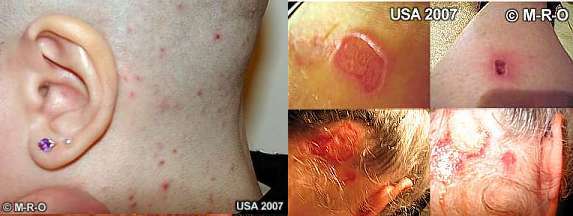
Most symptoms of the disease do not only affect the skin, but are multisystemic. Individuals (animals, humans) who have been under long-term stress or trauma and are likely to have metabolic disorders or long-term illnesses and thus have an insufficient HPA stress axis in the long run, rather than simply having a weakened immune system, are affected.
It is also possible that part of the immune system has been weakened by previous infections, such as Lyme disease, chlamydiosis, etc., or by cancer, diabetes, etc. Most of the symptoms of the disease (cutaneous, subcutaneous, systemic) are caused by biofilm blebs or hyaline, black or colorful polysaccharid filaments (filamentous biofilm).
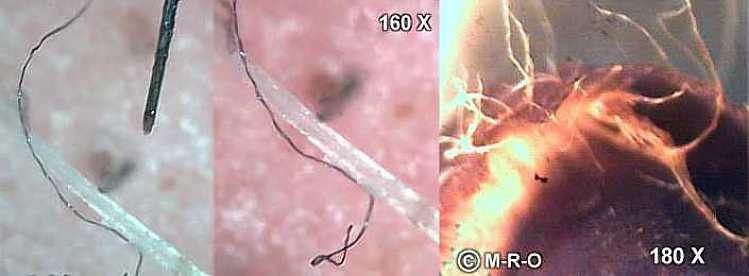
sweating or pressure on the lymphatic system, increasingly on the skin.
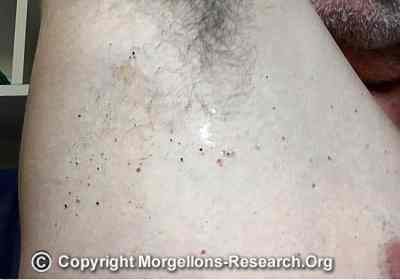
Sweated black specks (filament balls) under the armpit
Often
these filaments occur in advance only in the corners of the eyes,
eyelids, sinuses and ears. A skin disease can only develop later or not
at all, depending on the immune response of the affected person, which
is primarily a histamine-related, non-IgE-induced, allergic reaction to
the bacterial enzymes of the biofilm bacteria.
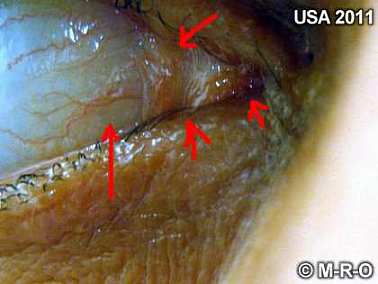
Chronic
conjunctivitis or inflammation of the tear sac (dacryozystitis) may
develop later or a later blindness may develop. The lower link also
describes an eye cornea-perforation
Source: University of Alberta/Canada - Morgellons disease leading to corneal perforation and enucleation

Main symptoms
Skin pustules, blisters, nodules, swellings, crawling sensations, mild to severe itching, vibrate under the skin, red spots or dots, eczema-like areas and depigmentation patterns, dermatitis, punctual bleeding/hematomas, lupus, cellulitis and thinner skin, hyperhydrosis
Graying of the hair, hair loss, bursted blood vessels, partial tissue athropy, ear pain/inflammation, tooth root inflammation, tooth loss, loss of teeth, lack of blood circulation, nose, fingers, ears, toes, genitals
Deep furrows and often swollen tongue, blisters at the tip of the tongue or edges, dry mouth and throat, redness of the eyes, eye infections, grey star, sensitivity to light, 3-D vision, blurred and poorer visibility, brunning, tearing eyes with granulate feeling in the eyes
Swollen and hanging eyelids and tear sac, swollen feet, legs and face (edema), small bruises (hematomas) or almost black and swollen ankles, fatigue syndrome, shortness of breath, fingers or wrist inflammation, stiff neck, reduced performance
Muscle reduction, twitching/cramps, balance disorders, chronic tough, asthmatic cough, frequent pneumonia, joint, back, and limb pain, gastrointestinal problems, asthma, COPD, emphysema, hypertension, heart stinging, cardiac rhythm disorders, circulatory weakness, frequent headaches
Nerve and muscle inflammation, hormonal and vegetative dysfunction, porous veins, nerves, forgetfulness, depression, anxiety, panic attacks, poor short-term memory, over-irritability, mood swings, poor concentration, brain fog, aggressiveness, general indifference
Anemia - lack of red blood cells - iron, vitamin D, B1, B6, B12, serotonin, folic acid. swollen lymph nodes, mammary gland swelling, Interstitial cystitis, kidney inflammation, prostata inflammation, tinnitus, sinusitis, upper abdominal pain, bloating, fibromyalgia, MS and Alzheimer's symptoms
Heart attack and stroke, thrombosis at any time possible, numbness in the fingertips or hands, carpal tunnel syndrome, face, legs, arms, hot flashes or cold sensitivity, drastic weight gain, diabetes II, cancer such pancreatic or cervical cancer possible in later stage
Biofilm Symptoms:
In the first stage of infestation (1st - 2nd month) after the onset of the disease, one initially feels only a few stings, pustules, blisters or itching. However, tiny, black dots (thread balls) are visible, which emerge from the skin pores at typical sweating areas.

Pustules or small blisters are more likely to occur when the skin is penetrated again and an allergic reaction of the skin to the bacterial enzymes occurs, similar to insect bites. Later, these symptoms may increase due to stress, sweating or moisturizing the skin.

Affected people also report that they subjectively feel the feeling of glass wool on the body, which is also known to pick and sting unbearably. There is also often a tingling or itching in the nose and mouth area, or partly also in the eyes and spread over the whole face and skalp area. Presumably they are produced by wandering/growing biofilms, which can cause not only nerve irritation and tingling, but also eczema and wandering red spots (erythema migrans) etc.
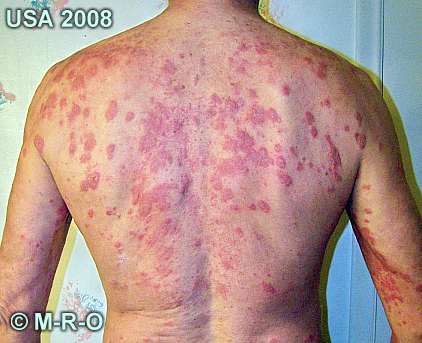
But even single, microscopic threads can cause fine tickling (neuropathy) when they grow out of the lymphatic and blood system and then out of the skin pores/hair shafts. One could also compare these fine sensations having contact with spider webs, which can cause similarly fine tingling sensations and nerve irritations on the head and face. However, the nerve stimulus arises mostly internally, directly on the nerves.

In addition to the first skin symptoms, swelling and congestion of the lymphatic system usually occur, whereby the feet can swell in such a way that one no longer fits in the shoes.
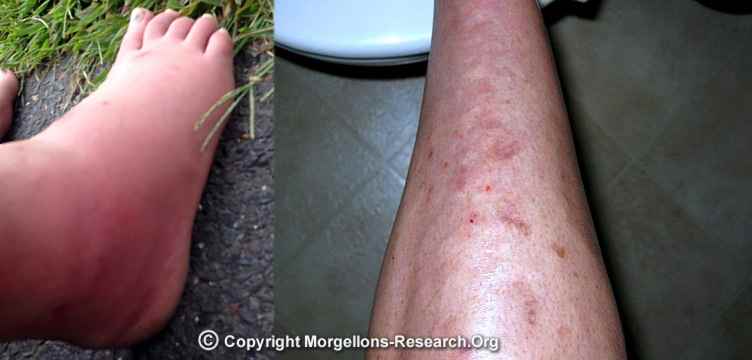
Frequently
also hematomas with dark or black feet. Furthermore, at the same time,
an increase in the HPA stress axis may be present to relieve the stress
situation.
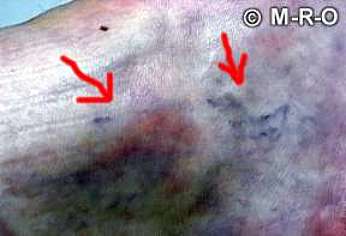
Only much later, when the stress becomes permanent stress, the HPA stress axis collapses and/or due to swelling in the brain area and pressure on the pituitary gland, pituitary insufficiency occurs, whereby the adrenal gland also suffers and produces less cortisol. Between these processes is then also the chronic fatigue syndrome. You sleep, but wake up dog-tired, as if you hadn't slept for days.
Very often, an electrostatic charge by surrounding magnetic fields can be another reason (phone, screen, etc.) that the bacteria become more active in the biofilm, and often also at full moon a different picture results. Since these bacteria only multiply at lower temperatures, filamentous growth takes place from the pores, towards the skin, with the development of fruiting bodies and later capsification, or the biofilm grows out with the hair root. See the pictures below:
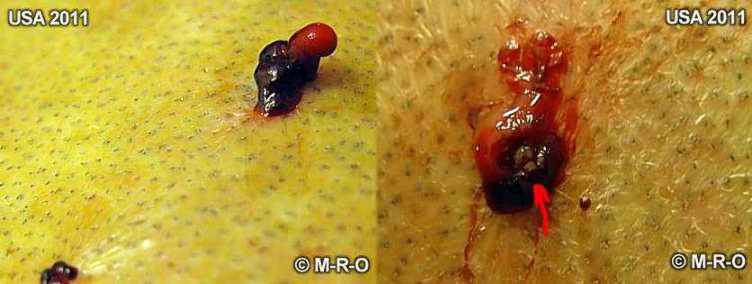
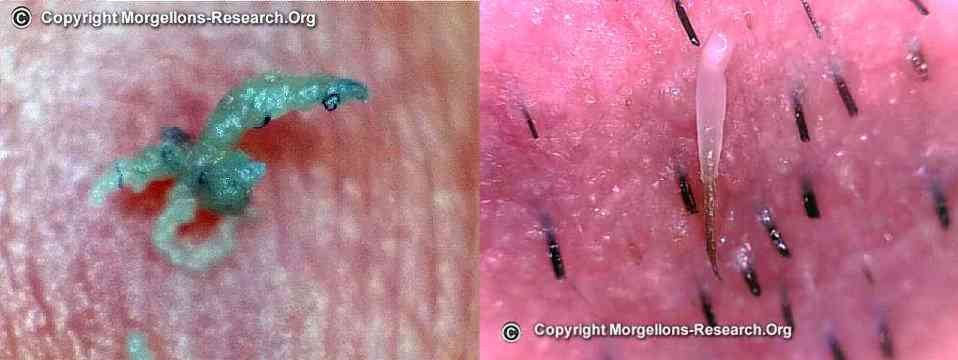

In any case, most skin symptoms are usually located near typical sweat zones, although this can affect different areas of each host body. Some sweat more hormonally in the chin area, others first on the nose, forehead, cheeks, belt line or on the hands and feet. Daily stress hormone release of the host body with increased sweating seems to be associated with stronger topical infestation symptoms. In the later stage of the disease, the clinical picture can generally deteriorate, also due to alopecia of the infested terminal hairs (leg and head hair, eyelashes, eyebrows, etc.), which can, however, regrow later.
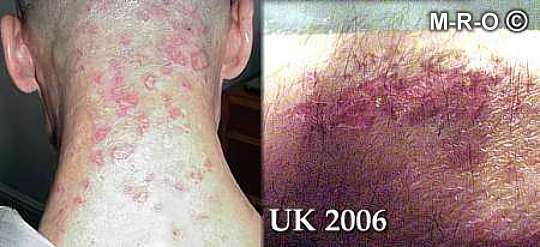
In
most cases, premature graying of the hair is also noticeable. In the
later course of the disease, formation of crusts can also occur,
erythema, eczema,
papules and nodules, as well as depigmentation patterns (white spots),
which are caused by melanin absorption. Often the melanocytes in the
human skin are destroyed and the white spots remain. In addition, the
clinical picture can be significantly enhanced by severe anti-immunity
influences, malnutrition and also skin scratching effects
(super-infection).
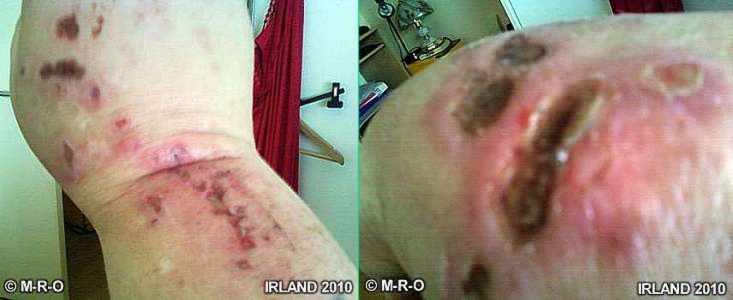
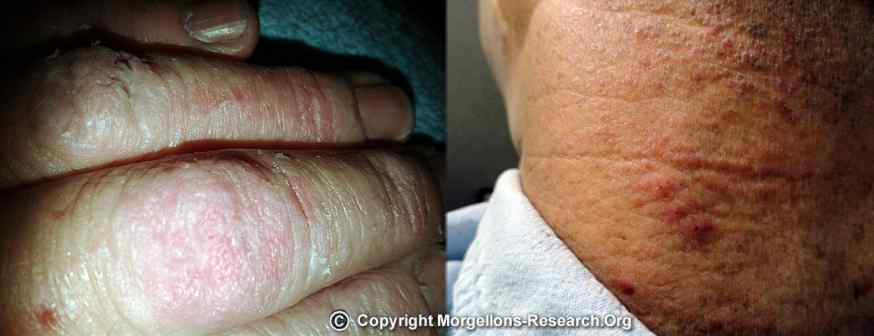
In particular, anthrax-like, crater-like wounds such as from B. megaterium are produced.
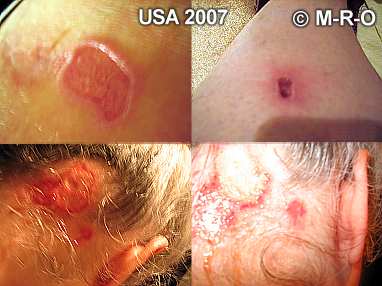
The
biofilm and bacteria are found alternately in the large and small
intestine, the lymphatic system, subcutaneously and in the skin pores.
Topical phenomena sometimes occur more or less and are therefore not a
criterion for definitive disease detection. Because we are not dealing
with a skin disease. Depending on the coincidence, threads can only
settle in the area of the eyes, mouth, nose, or throat in the initial
phase of an infection, and only later can they migrate through
ingestion into the intestine and bloodstream and then through the whole
body. In the intestine, mucosal inflammation and an ulcer can develop.
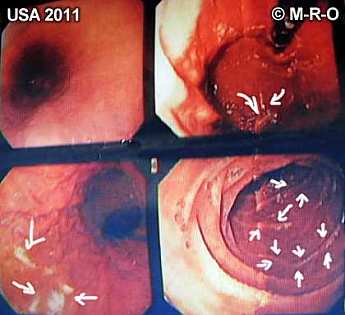
Therefore, increased kidney and bladder pain and an increased urge to urinate may occur. Sometimes without signs of bacterial infection, but due to mechanical irritation in the tissue (interstitial). Moist areas of the skin as well as the entire mouth area (throat, tongue, lips), nose and sinuses and eyes are generally preferred and are usually always affected in a later phase. So wherever there is more nitrogen in the body, there is a stronger colonization of the bacteria.
But also areas such as skin and hair, when the threads or biofilm bulk grow out of the pores/hair shafts. In the further course, microfilaments may also occur within a pre-sponsor period of a few weeks. With connective tissue nodes and granulomas. Often also in the oral mucosa. In other areas of the skin, chronic dermatitis may also develop and increased pigmentation (dark melanin spots) or depigmentation (bright spots) of the skin, lichenification (lichen) and tissue atrophy or sarcoidosis, blistering, itching, papuous exanthemandism and lymphadenitis.
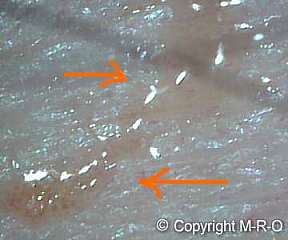
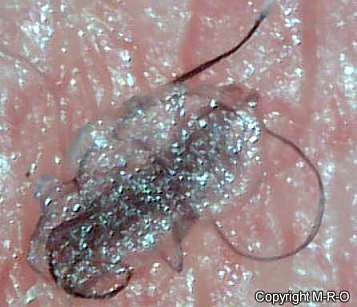
Biofilm on the skin
It's really hard to believe that bacterial colonies can also make rapid movements. In this and other known cases, one simply has to accept it, when it comes to such unusual phenomens in nature. See this video clip about filaments/threads moved by Bacillus subtilis.
Motions caused by Bacillus subtilis macrofibres result in new forms of movement of the multicellular structures (Mendelson et al., Microbiology)
As primary, immunosuppressive diseases, other bacterial infections, as well as viral diseases, mycoses, cancer and chemotherapy, corticosteroid therapy, endocrine diseases, long-term stress, autoimmune diseases, metabolic diseases, diabetes mellitus, Hashimoto and Cushing syndrome, etc., could also play a role.
Very often, despite skin infestation, no redness or other typical skin symptoms are visible, which could indicate a typical infestation area. But you can also use a black light lamp to make the filaments partially invisible to the eye visible on the skin.
Infestations in the forehead area can initially only be recognized by a slight lift or quad or elongated stripes, which can sometimes extend over the entire forehead. This represents, in the proper sense, the beginning of a gradual undercavity of the skin in this area, followed by a later tissue reduction.
In the genital area, for example, men only find a pustule from time to time and is also rather the exception, but mostly around the genital area, especially at the scrotum. Sometimes redness and pimples also occur on the glans.
The bacteria are rather subcutaneous and feed on remaining urine (nitrogen source) on the glans. Unfortunately, this also results in a slight loss of tissue on the glans. In women, these threads are also detectable in the vagina, uterus, labia (pustules, black dots, white threads) and on the cervix.
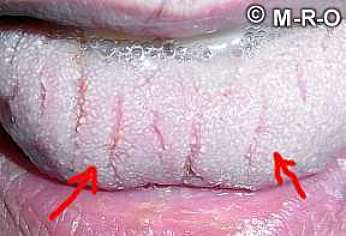
Very often, a swelling of the tongue occurs, or with deep furrows
Furthermore, the immune system in patients can be greatly weakened by additional viral, bacterial, and mycotic co-infections. In addition, autoimmune diseases such as Lupus SLE, Hashimoto, Renaud Syndrome and SJOGRENS Syndrome, as well as cancer can develop in parallel, if not already present. In general, these bacteria can be spread throughout the body through the bloodstream and lymphatic system.
In particular, sooner or later they enter the peripheral extremities of the body (eyes, nose, ears, skin, hair/hair roots, fingers, feet, toes, tongue, gums. Tooth root, nipples, genitals, scrotum, cervical mouth, etc.), where, depending on the higher blood circulation, they are also increasingly washed up there and enter the surrounding tissue via the capillary vessels.One could almost compare it to the distribution of river gold that is deposited in the curves and shallow waters. If bacteria filaments then drill themselves out of the fine capillary vessels and thus damage them, then this can be recognized on the skin as a hematoma (blood pouring into the tissue) and also in the capillary vessels of the eyes, which then appear reddened or blood-drained. In the case of an external re-infection, these organisms and their threads drill into the host skin quite quickly (approx. 6-10 sec.).
The penetration into the skin is very painfully noticeable as a stitch or bite and becomes visible in the form of a larger skin swelling. What is associated with an allergic reaction of the skin, due to proteolitic enzymes of organisms with skin-etching/dissolving properties (keratinase, protease and liptase), but without being typical keratinophilic pathogens like some fungi. In the late stages of this disease, expanding biofilm filaments can spread like a spider web under the skin and possibly connect. Pustules and pimples can now occur anywhere due to external pressure on the skin.
It is generally promoted the formation of wrinkles and the graying of the hair faster and it can be said that this disease makes a person age faster and make him look older. The ever-increasing stress with this disease does the rest. Animals cannot cope with this stress for long and die for example from circulatory or heart failure. Daily but incorrect hygiene can also play a major role, which can sometimes even encourage spread.
Therefore, further measures should be taken to avoid the spread of pathogens. According to the manufacturer's description, Agrobacteria should be rinsed with water for at least 15 minutes after contact with the skin and eyes. Clothes should not be brought home under any circumstances. Thanks for the info dear distributor!

In a later phase of infection, general physical weakness, shortness of breath and reduced performance occur, followed by chronic fatigue syndrome accompanied by concentration problems, irritability and forgetfulness. Swelling of the lymph nodes, hair loss and wrinkle formation of the skin, pigment disorders as well as visual disturbances and corneal opacity of the eyes also occur. Paired with tingling or numbness of extremities (carpal tunnel syndrome) and later hardening/tension of the nerve strands and muscle fibers.
Irregular skin thickness, cellulitis, collapsed, red and diluted skin areas (Acrodermatitis chronica atrophicans) can also occur, and premature aging of the skin is also generally forced (paper skin, collagen loss, tissue loss).
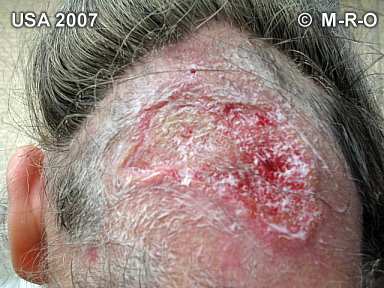
Through the lymphatic system and the subsequent eye discharge, an infestation or irritation of the anterior and posterior occular segments (nerve endings, trigeminal nerve), the eye muscle (symptom blur) and the retina can take place. Also a foreign body feeling and a one-sided redness (mostly right) of a pair of eyes is sometimes present, as well as inflammation conjunctiva and a blurred view, 3-D view paired with small flashes of light in the eyes, as well as gray and black shadows.
Many eye diseases such as keratitis or a clouding of the cornea or temporary irritation is probably caused by chemical (biofilm+enzymes), or mechanical stimuli (biofilm granules). If one looks at white backgrounds, then often also on the Cornea thread-shaped inclusions can be seen. With diagnostic eye drops such as the contrast agent Minims made of fluorescein sodium (fluorescent dye) you can make these elongated inclusions or scratches visible.
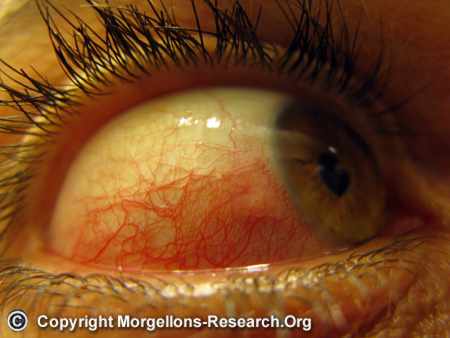

Numerous neurological disorders are also present, as well as arthritis, Alzheimer's and fibromyalgia. or muscle wasting, signs of auto-immune disease, as well as head and limb pain, tinnitus, general irritability, depression, wineiness, mood swings, anger and resignation, agony, apathy, schizophrenia and even suicidal thoughts can occur more often.
Furthermore, gastrointestinal disorders (diarrhea, bloating, reflux), unexplained back pain, edema of the legs (lymph), stiff neck and limbs, thrombosis, shortness of breath, heart failure and liver failure are added.
In case of infestation of the throat or lungs, the disease can be worsened by a chronic cough and tough mucous ejection. After a prolonged infestation of the lungs, chronic bronchitis or pneumonia can develop, which can worsen additionally due to co-infections from the bacteria Chlamydia pneumoniae or/and enterobacteria such as E. coli and Klebsiella strains. Asthma, COPD, pulmonary emphysema and fever-like and chill-like conditions can also occur more often.
Many sufferers also generally have worse teeth with gum loss (periodontosis) and also tooth loss. As well as urological problems (bladder, kidney, prostate), scaly, dry skin, circulatory disorders (cold nose, ears, hands probably due to cortisol deficiency) and also a tissue reduction on the sexual organs (penis, labia) are recognizable in the final stage.
If it spreads to internal organs or in the abdominal cavity and chest cavity, then it can also lead to an inflammation of the appendix even in the age of 50 or 60 years. Meningitis, epilepsy, encephalitis, stroke and schizophrenia may occur when the meningitis or brain is infested. Blindness and paralysis and numbness can also occur, constantly or sporadically, possibly cancer or a heart attack and stroke may occur later. Among the many consequences of this spread process of the bacteria are also cellulitis, burst veins, edema, thrombosis, arteriussclerosis-like symptoms.
Many symptoms can also flatten or disappear completely, or break out again after years due to an increased stress condition (trauma) and reduced immune defense of the
body. Due to the manifold disease symptoms, many other opportunistic pathogens may also be involved in the entire clinical picture, such as viruses (herpes), or bacteria and fungi, such as Staphylococcus aureus, Streptococcus pneumoniae, Enterobacteria, Aspergillus spp. and Candida.
Similar symptoms such as CFS, meninigitis, encephalitis can also be caused by viruses such as varicella, coxsackie, enterovirus, EBV (Ebstein-Barr virus), herpes simplex type 2, LCM virus and HIV, and also by enterobacteria (E.coli) Streptococcus group B, and Listeria monocytogenes.
More often, it can affect older people, children and babies or immunosuppressed individuals, but also healthy individuals if they have a temporarily stress-related weakened immune system, etc. Final comment: Due to a biofilm infection, one is in a constant state of shock and is severely traumatized. You also have enormous difficulties in maintaining your usual social life.

PATIENT'S PATH OF SUFFERING:
Morgellons disease is the grim reality in
the US and many other countries around the world. The suffering of
these people is more than unimaginable, and this cannot be compared to
AIDS, cancer or other known diseases.
Even the enormous logistics with clothes and laundry are almost impossible to cope with on their own and are becoming more and more debilitating every day, especially since even higher-degree washing operations cannot kill these Morgellons biofilms. Overwhelmed by the enormous stress, one decays from a certain point in time into lethargy, isolation and increased inability to live.
A visit to the doctor seems useless at some point and is only a time waste and expense. These emotional strains often turn into anger and aggression, which are sometimes left out at their own doctor.
Understandably, if the doctor does not want to or can not grasp the drama of the situation properly, since he is very attentive to his budget, has no time anyway and does not want to deal with the fate of these sick people mentally, and then deliberately sible them as simulants or mentally ill people. In this way, he also promotes on top psychosis in the patient, which can often lead to a misinterpretation of the doctor.
He then (if not before) probably classifies the patient as mentally ill and sends him home with the diagnosis "DOP" and with psychopharmaceuticals like "Haldol", that has extremely bad side effects and is even absolutely despised by heroin addicts.
The only party that benefits from this is the pharmaceutical industry! Antidepressants such as Zoloft can even lead to suicide. All this happens more often than thought, without that a doctor would have performed a proper examination at all, and this is interpreted by the patient as a deliberate appeasement and ignorance and meets a total incomprehension.
Incomprehensibly, however, these very signs are misinterpreted by most doctors as drug or alcohol addiction. In principle, it is even fashionable to take natural remedies (Valerian, St. John's wort, etc.) or even certain psychopharmaceuticals to calm the patient and also the microorganisms, as more stress worsens the symptoms!
However, in such difficult cases, a good doctor should refer patients to infection specialists in order to initiate examinations for further clarification. In any case, different cultures should be made of the filaments, rather than just antibody tests.
Treatments should be carried out especially after clinical symptoms, even if a test was negative. In the interests of the patient, the humanistic intention applies here too, in case of doubt help the patient, and not the other way round, in case of doubt help the health insurance company!